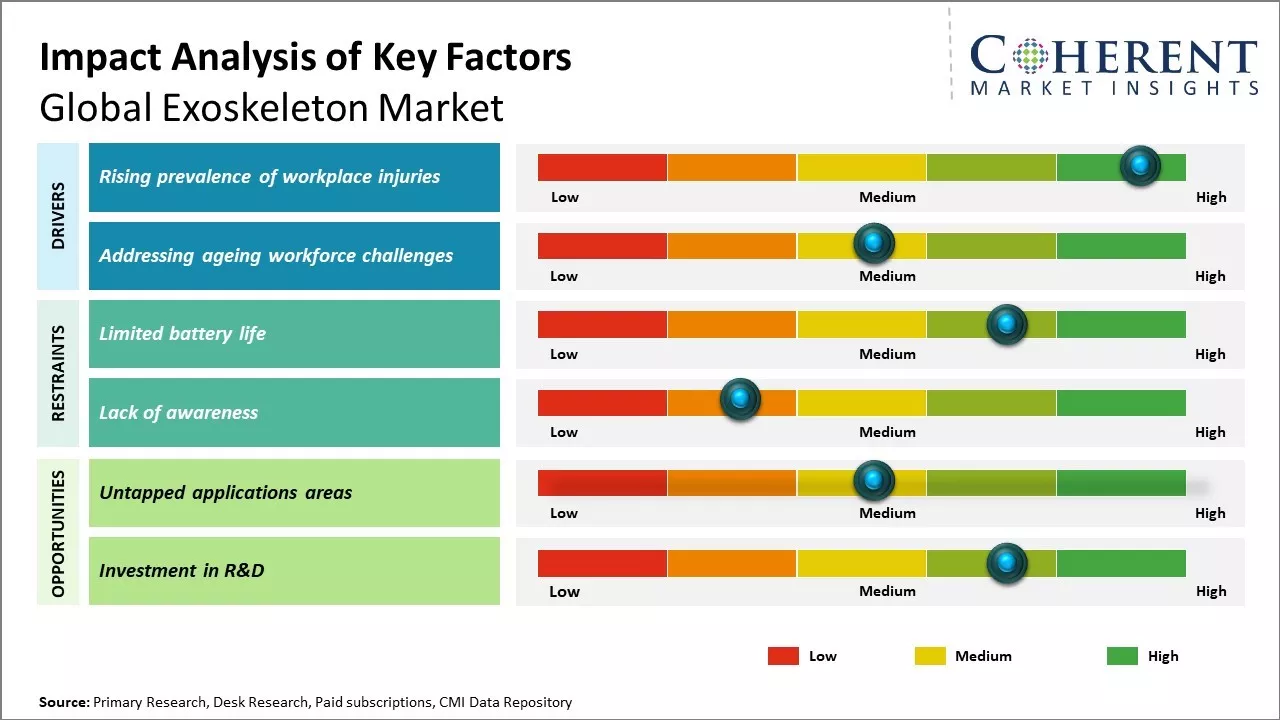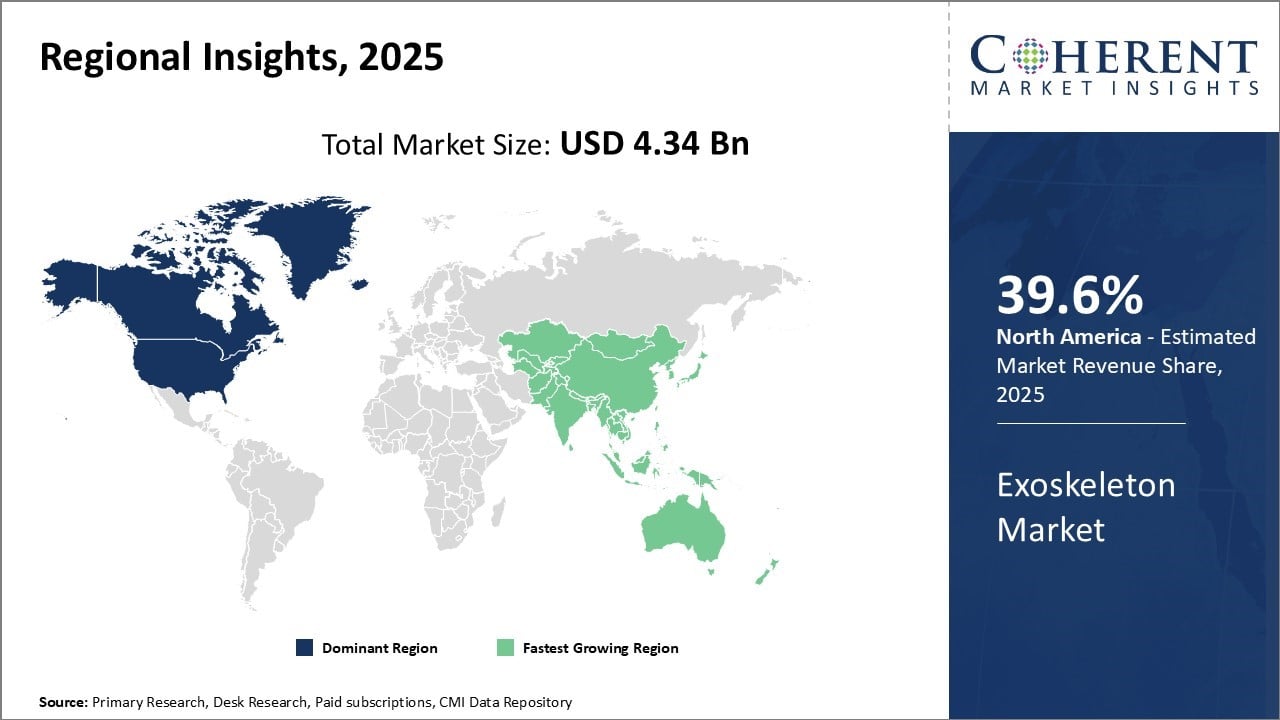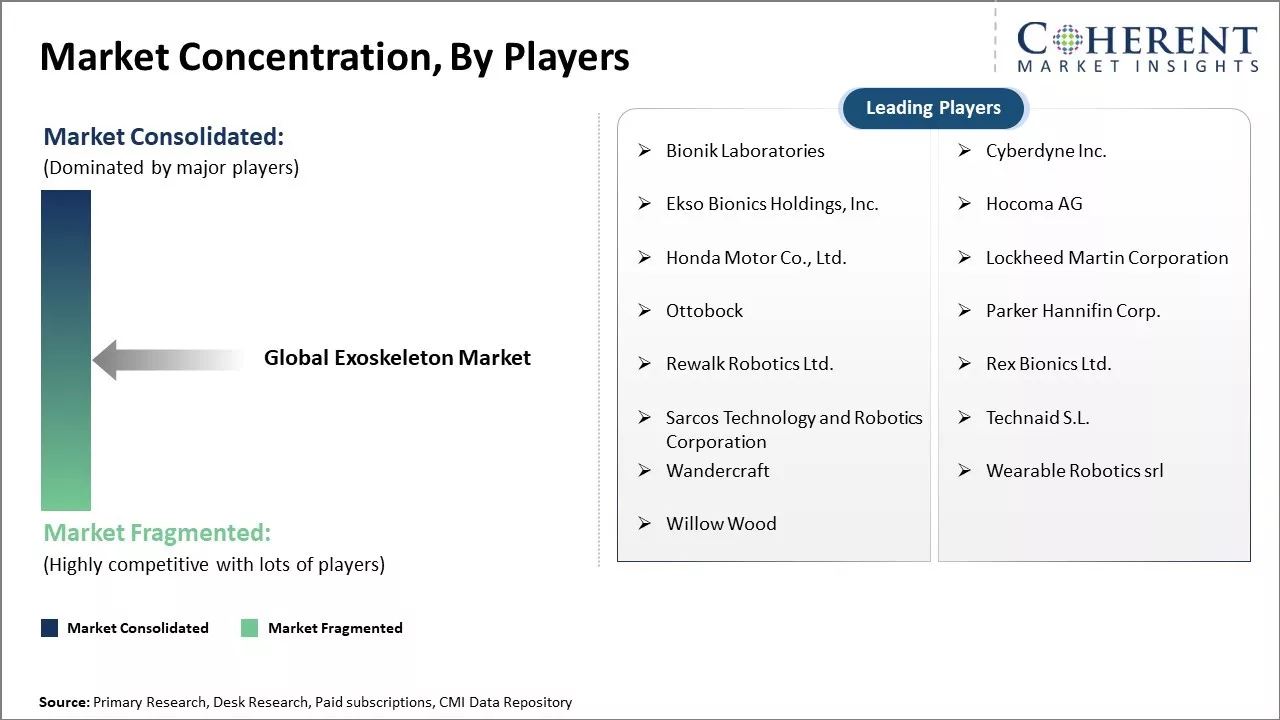The global exoskeleton market size is estimated to be valued at USD 4.34 Bn in 2025 and is expected to reach USD 12.95 Bn by 2032, exhibiting at a compound annual growth rate (CAGR) of 16.9% from 2025 to 2032.

To learn more about this report, Download Free Sample
Ongoing advancement and continued R&D in exoskeleton technologies aimed at increased application across industrial and healthcare sectors is expected to drive the market growth. Increasing application of exoskeletons for rehabilitation of people with walking disabilities and paralysis is expected to support market gains. Military defense with exoskeleton technology is increasingly being adopted to improve soldier mobility and reduce fatigue, driving new growth opportunities in the exoskeleton market. However, high product costs and lack of reimbursement policies related to medical exoskeletons may negatively impact the market in the short term. The key players operating in the market are making significant investments to develop affordable and user-friendly exoskeleton solutions.
|
Event |
Description and Impact |
|
Aging Population and Healthcare Labor Shortages (Macro-Level Demographic) |
|
|
AI and Battery Technology Breakthroughs (Nano-Level Technological) |
|
|
Global Supply Chain Disruptions and Manufacturing Reshoring (Macro-Level Economic) |
|
Uncover macros and micros vetted on 75+ parameters: Get instant access to report
In terms of Offering, the Hardware segment is estimated to account for 59.2% share of the market in 2025 owing to continuous engineering innovations to enhance exoskeleton capabilities. Hardware manufacturers constantly upgrade design and integrate latest technologies to tackle challenging physical tasks. Advanced powered mechanisms with customized fittings have widened their applications.
New electrical and mechanical components improve weight distribution and accuracy of assisted movements. Use of durable composite materials and efficient battery systems boost hardware's operational efficiency. Simultaneously, focus on functionality and ergonomics facilitates long duration wear.
Ability to interface with various software controls according to situational needs extends hardware's adaptability. Continuous customization as per anatomical variations expands their outreach. Collaborations with research institutes aid design thinking from diverse perspectives. Hardware players thus maintain edge over other offerings by resolutely furthering cutting-edge innovations.
Powered exoskeletons are estimated to hold 61.8% market share in 2025, driven by rising clinical credibility and tangible care outcomes. Extensive research has demonstrated their efficacy in assisting mobility for patients with spinal cord injuries or weakened muscles. Powered designs with rechargeable battery packs independently drive movements, boosting user autonomy.
Accumulating case studies reassure therapists and patients, while regulatory approvals after rigorous testing strengthen commercialization prospects. Collaboration between manufacturers and clinicians helps custom-design exoskeletons for complicated conditions.
Growing acceptance within neuro and orthopaedic rehabilitation bolsters powered exoskeleton market dominance as clinical evidence validates their superior assistive capabilities compared to passive designs.
The healthcare segment is estimated to hold 46.7% market share in 2025, driven by escalating demand for mobility assistance. Aging populations and the prevalence of disabling conditions worldwide augment this requirement. Exoskeletons enable therapists to start early interventions, potentially aiding complete recovery. They also allow patients to independently perform daily chores, enhancing quality of life.
Participation in physical therapy is more effective and sustainable with exoskeleton-mediated gait rehabilitation and reduced fall risks. In some developed countries, healthcare insurers have started coverage for exoskeleton-based treatments, reinforcing their credentials.
Promising outcomes across diverse indications including spinal injuries, multiple sclerosis, and paraplegia have established a foothold within clinical settings. This sustained healthcare demand subsequently increases adoption across other application spaces.

To learn more about this report, Download Free Sample
North America dominates the global exoskeleton market with an estimated 39.6% share in 2025, owing to strong presence of major exoskeleton manufacturers in the region. The U.S. houses headquarters of leading players like Ekso Bionics, Parker Hannifin, Rex Bionics, and Suit X which are extensively focusing on developing advanced exoskeleton solutions for healthcare and military applications. Moreover, large defense spending and continuous technological advancements in the country support product development activities.
Additionally, rising venture capital investments in exoskeleton startups have accelerated commercialization of various prototypes. The region is also an early adopter of exoskeleton technologies due to growing geriatric population and rising prevalence of diseases like stroke that limit mobility. Leading healthcare providers are actively pursuing clinical trials to evaluate benefits of exoskeleton-assisted therapy.
Asia Pacific exoskeleton market is growing at the fastest pace and emerging as a major hub for exoskeleton manufacturing. Countries like China, Japan, South Korea, and India are aggressively investing in exoskeleton R&D activities to gain competitive edge in global trade. For example, the “Made in China 2025” strategy focuses on promoting local production of medical robots and assistive devices including exoskeletons. This has attracted global players to establish joint ventures with local manufacturers to leverage low labor costs and tap into the huge patient population in Asia Pacific region.
China in particular has emerged as the top exporter of low-cost exoskeleton components due to wide presence of electronics and automotive component suppliers. Considerable difference in pricing of exoskeleton systems in Asia Pacific compared to other regions is another factor fueling sales growth. Additionally, Asia Pacific countries are witnessing rapid aging which is anticipated to significantly drive the demand for exoskeleton-assisted rehabilitation and care in the coming years.
| Report Coverage | Details | ||
|---|---|---|---|
| Base Year: | 2024 | Market Size in 2025: | USD 4.34 Bn |
| Historical Data for: | 2020 To 2024 | Forecast Period: | 2025 To 2032 |
| Forecast Period 2025 to 2032 CAGR: | 16.9% | 2032 Value Projection: | USD 12.95 Bn |
| Geographies covered: |
|
||
| Segments covered: |
|
||
| Companies covered: |
Bionik Laboratories, Cyberdyne Inc., Ekso Bionics Holdings, Inc., Hocoma AG, Honda Motor Co., Ltd., Lockheed Martin Corporation, Ottobock, Parker Hannifin Corp., Rewalk Robotics Ltd., Rex Bionics Ltd., Sarcos Technology and Robotics Corporation, Technaid S.L., Wandercraft, Wearable Robotics srl, and Willow Wood |
||
| Growth Drivers: |
|
||
| Restraints & Challenges: |
|
||
Uncover macros and micros vetted on 75+ parameters: Get instant access to report
The global exoskeleton market outlook is positive, fueled by the rising prevalence of workplace injuries across various industry verticals driving increased adoption. Strenuous activities involving repetitive motions, heavy lifting, and prolonged standing put significant strain on the body and often lead to musculoskeletal disorders over time.
Jobs in manufacturing, construction, warehousing, and package delivery are particularly prone to such ergonomic challenges. Prolonged periods of standing on concrete floors can cause stress on the back and legs. Similarly, repetitive arm motions in automated production lines and assembly workstations increase the risk of injuries in shoulders, elbows, and wrists.
The constant stress often results in musculoskeletal disorders like tendinitis, carpal tunnel syndrome, and lower back pain among workers. With strict deadlines and delivery commitments in various industries, companies can afford such losses. Many are now actively looking for technological solutions to prevent injuries, promote wellness of workers, and optimize their operational efficiency.

To learn more about this report, Download Free Sample
A major driver for the growing exoskeleton adoption is the challenge of an ageing workforce in developed economies. With improving life expectancy and declining birth rates, the average age of populations is rising steadily across regions like Europe, North America, Japan and Korea.
This poses unique human resource challenges for companies with physically demanding job roles. Older workers face higher fatigue levels and are more prone to injuries while performing tasks involving manual handling, repetitive motions, and prolonged standing. It is difficult for them to sustain the same level of productivity as their younger colleagues.
At the same time, there is a severe shortage of new entrants into manufacturing and construction industries due to societal preferences of younger generations for more comfortable office jobs. This has started impacting business continuity plans of many companies.
In this situation, full body assistive exoskeletons can provide valuable support by reducing physical stress on the body and enabling extended performance of job tasks. They allow older employees and those recovering from injuries to stay active in work place and utilize their valuable skillsets and experience.
There are several emerging application areas for exoskeletons that could drive significant growth in the global market. One major untapped area is using exoskeleton technologies to aid healthcare workers who are on their feet all day assisting patients. Exoskeletons can help reduce stress and fatigue for nurses, physicians, and other staff by supporting their joints and reducing ergonomic strain over long shifts.
As populations age globally and healthcare demands rise, helping the workers on the frontlines will become increasingly important. This application could see widespread adoption in hospitals and elderly care facilities around the world in the coming years.
Another promising untapped area is using light exoskeletons designed for personal consumer and commercial use. Devices are being developed to assist with labor intensive jobs in construction, warehousing, and manual material handling. This could help workers lift heavier items, support fatigue over full work days, and reduce injury risks.
Exoskeletons may soon play a role in supporting workers fulfilling skyrocketing e-commerce orders and last-mile deliveries. The International Labour Organization (ILO) estimated that there will be a 13% global increase in physically demanding jobs in non-routine manual sectors by 2030. Emerging exoskeleton technologies are well positioned to address these projections and future proof many industries.
As exoskeleton designs mature and costs come down, broader consumer and commercial adoption will further propel the global market upwards in the coming years. The potential for new application areas to emerge is high as technology and user demands continue to evolve in tandem. These trends point to significant growth opportunities for exoskeleton providers willing to innovate in untapped markets.
Definition: The global exoskeleton market value is driven by medical and industrial exoskeletons developed using the latest robotics technology. These power assist robotic structures are externally worn to enhance or restore human performance for various applications. Medical exoskeletons help physically disabled patients in rehabilitation therapy, while industrial exoskeletons assist workers in manufacturing, construction, and logistics industries by reducing physical strain and risk of injuries from activities requiring extensive manual labor over long hours. The global market is expanding rapidly due to growing need for industrial automation and medical devices for rehabilitation and elderly care.
Share
Share
About Author
Monica Shevgan has 9+ years of experience in market research and business consulting driving client-centric product delivery of the Information and Communication Technology (ICT) team, enhancing client experiences, and shaping business strategy for optimal outcomes. Passionate about client success.
Missing comfort of reading report in your local language? Find your preferred language :
Transform your Strategy with Exclusive Trending Reports :
Frequently Asked Questions
Joining thousands of companies around the world committed to making the Excellent Business Solutions.
View All Our Clients